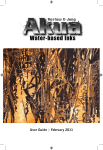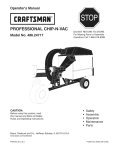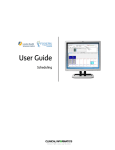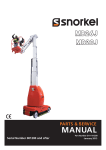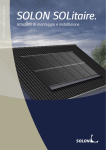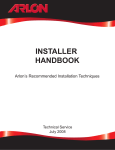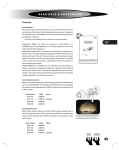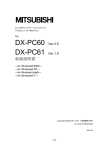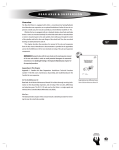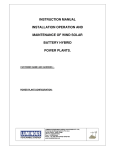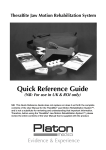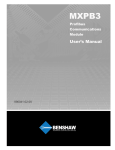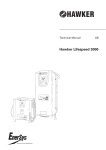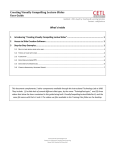Download Tube -Line 5500 Operators Manual - Tube
Transcript
Tube - Line 5500 X 2 Owner’s Manual 2008 Manufactured By: TubeLine Manufacturing Inc. RR#3 Listowel, Ontario , Canada N4W 3G8 Tel: (519)291-4162 Fax: (519)291-5388 e-mail: [email protected] TubeLine 5500 X2 New for 2007 1. Reinforced the front Ram Cross Tube at the bolt-on point. 2. Slide tubes instead of Flip-out Arms for the final push-off 3. Channel Track at the bottom of the Safety Door 4. New Safety Door handle 5. Changed battery location 6. Better Engine Access 7. Improved engine shielding and Fenders 8. Decal for bale size on Bale Saddle 9. Removable Tapered Bale Spears 10. New Hillside Roller 11. Riser Table side angles turned down (more clearance for plastic 12. Longer Riser Table Handle 13. Twin wrap added a plastic roller to guide film over edge of wrap carrier Introducing Tubeline T5500 X2 Tubeline Owner Thank you for choosing the Tubeline Bale Wrapper. Our hope is that it will give you many years of productive service. This machine is designed to wrap a film of plastic in a continuous line of round or square bales. Please read and understand this manual and the machine before operation. Warranty and Limitation Of Liability All Equipment is sold subject to mutual agreement that it is warranted by the company to be free from defects of material and workmanship. But the company shall not be liable for special, indirect or consequential, damages of any kind under this contract or otherwise. The company's liability shall be limited exclusively to replacing or repairing without charge, at its factory or elsewhere, at its discretion. Any material, or workmanship defects which become apparent within one year from the date on which the equipment was purchased, and the company shall have no liability for damages of any kind. The buyer by the acceptance of the equipment will assume all liability for any damages, which may result from the use or misuse by his employees or others. Warranty coverage is null and void unless Warranty Registration form has been completely filled in and is on file at Tube-Line Manufacturing Inc. 1 Safety Take note! This safety alert symbol is found throughout this manual to call your attention to instructions involving yourself and others working around the machine. • Failure to follow these instructions can result in injury or death! This symbol means -Attention! -Become Alert! -Your Safety is involved! Signal Words are used in this book. Caution: Indicates a potentially hazardous situation that may result in injury. Warning: Indicates a potentially hazardous situation that could result is serious injury or death. Danger: Indicates a hazardous situation that needs to be avoided. It is you the operator that needs to be aware of these dangers. If you have any questions not answered in this manual, please contact your dealer or Tubeline Manufacturing Inc RR # 3 Listowel Tel: (519-291-4162 Ontario Canada Fax (519-291-5388 N4W 3G8 e-mail [email protected] 2 Safety -- It’s in your interest. Safety Guidelines Safety of the operator is one of our main concerns, however we do hear of some accidents that could have been avoided if some precautions had been taken. To avoid personal injury study the following precautions and insist those working with you or for you, follow them. In most cases the pictures will have the shielding in place, in some they may be removed, only to show a view behind the shield. Keep all the shields, safety doors in place. If they become faulty and fail to work replace them. They are for your safety, do not operate the equipment with them removed. Replace any decals that may be missing or that are not readable. Location of the decals is indicated in this manual. Do not operate this machine while under the influence of drugs or alcohol. Review the safety instructions with all users annually. This equipment should not be operated by children, or with those unfamiliar with the operation of the machine. Do not allow persons to operate this machine until they have read this manual and/or were instructed by a qualified person. Do not paint over, remove or deface any safety signs or warning decals on your equipment. Observe all safety signs and practice the instructions on them. If the bale seems to be larger then the hoop do not try to force the material through as the film spools my touch the bale and break the plastic. If it stalls halfway through you can’t back up, you will have to pull the bale apart by hand. Lighting and marking This machine is equipped with lights and reflectors as required by the most stringent government and ASAE specifications. They should work with the tractor plug. You may have to make an adaptor when towing behind a truck. 3 Safety Decal Location A B D C F G E H I J Serial Plate 4 A B Both Sides Both Sides C D E F 5 G H Both Sides Amber Reflector Strip I J Red Reflector Strip • Keep safety signs clean and legible at all times • Replace safety signs that are missing or illegible • Decals are available through your Dealer, Distributor or Factory. Maintain proper tire pressure at all times • On the rear axle replace tire with the same type and brand if possible. If this is not practical then replace with a tire that has the same outside diameter as the original as the brakes may or may not release. (We have found ¾” diameter difference between brands) 6 Remember Your best assurance against accidents or damage to the machine is to know how it operates. If you do not understand a portion of the manual or a function of the wrapper please contact your dealer or an experienced operator. Before Operation • • • • • • • Carefully study and understand the manual or be trained by an experienced operator. Do not wear loose clothing that may get caught in moving parts. Visually inspect the machine to make sure no parts are loose or missing Be sure that no tools are left on the machine Make sure no hay is lying on the engine and that the cooling fins are not clogged with dust and hay (this could cause a fire) Do not hurry the learning process. Be familiar with one part before trying the next part. Practice by running the machine through its paces, first in manual mode with no bales in the machine until you are comfortable and familiar with the operation. After you become familiar with the operation, switch the machine to Auto mode. Use a stick and push the table switch down to start the cycle. Do not reach in and push the switch paddle down by hand. 7 Tube Line Set up If bales are brought to the site before wrapping, arrange them to allow easy access to bales and allow Wrapper plenty of room to move. Spacing Width of Bale Apart Note Initially takes 4 to 6 bales before Wrapper moves Direction of travel The First bale tips as the line forms and may be picked up when the row is well started. A bale of hay or straw is added to protect the end of the line. Silage Hay/ Straw 8 Operating the Model TL5500 X2 Tube-Line Bale Wrapper Big Bale Silage The objective of big bale silage is to provide high quality forage using a minimum of equipment. To do this, crop must be cut at the correct stage of maturity, wilted, baled tightly and wrapped air tight, using a good quality stretch wrap. The Tube-Line wrapper makes timely harvest possible by reducing the dependence on the weather. It is much easer to get to wilt silage then to make dry hay. This also extends the working day, as the correct moisture to bale earlier and later in the day. Bales Well-shaped firm bales are necessary for successful wrapping, using a hard-core baler. Bales are best wrapped as soon as possible after baling. If bales are left unwrapped they will sag and loose shape. Heating will start soon after baling and protein quality will be lost. It is desirable to wrap within four hours. In an emergency such as rain, the bales can be left 12 to 16 hours. Moisture Successful silage can be made over a wide moisture range. In general, 40 to 50% moisture is satisfactory for dairy cows. Some beef farmers prefer 60 to 70% moisture as it limits intake. A good rule of thumb is to dry “Half-way to Hay”. Drier silage gives you 1. 2. 3. 4. Lighter bales to handle More desirable fermentation with fewer odors Less freezing in the winter Higher dry matter intake Wrapping Site Select a site that will allow room to make an adequate bale row length. The Tube-Line is a very fast wrapper, but requires time to set up and move to a new line. There should be space for at least 50 bales in a row. Select a site that is accessible in winter conditions and does not flood in the spring. A firm surface is necessary for the successful operation of the Tube-Line wrapper. Avoid soft ground, as the wrapper will not move forward smoothly if it is sinking into the ground. Wrap on level ground or a slight uphill grade. A site that is free from grass and debris will be less likely to attract rodents that can damage the plastic. 9 Bale Size Round Bales The Model TL5500 X2 will wrap bales up to 5 ½’ wide and up to 5’ high. It will wrap all sizes smaller then these dimensions as well. Remember when making big bale silage the bales will be heaver them dry hay. This puts extra strain on loading and transporting equipment. Also, bales will be heavier when feeding out and may have to be moved on wet ground or snow. As a result most operators reduce silage bale diameter to 4-4 ½’, even though the wrapper will handle larger size. Square Bales The Model TL5500 X2 will wrap most sizes of square bales. The length should be reduced to 5’. This is to allow the bales to be placed on the bale receiver. This may also be the maximum length advisable to handle big bale square bales of silage. Bales, which are approximately 4’ wide and 2’ high can be stacked two high for wrapping, one drawback, the ends of the bales tend to be rounded somewhat and will form an air tunnel the full length of the row. Bales, which are approximately 3’ wide and 3’ high, do not stack well. These may be wrapped in a single tier of bales Recommended Operating Procedure We suggest the following method or operating the TL5500 X2 Tube-Line Wrapper. • Park the wrapper where you want the end of the row to be, facing in the appropriate direction. • Fold in the first section of the tongue and fasten the bracket into the hydraulic steering slider with the pin that held the tongue. • Undo the tail Tiebar hairpin and lay the bar over the rear axle and put the hairpin back into place to prevent loss. Danger: To prevent injury! Prior to lowering the tail section, be sure to check that all bystanders are standing clear!! • Lower the tail section using the manual operating valve. 10 Caution!! Be Safe Never ride on the machine while being used or transported Never climb on the table or inside the wrap chamber with the Engine running Turn control panel to “man” or stop the engine when changing plastic rolls. Never leave it in “auto” as your helper may set a new bale on the table or press the start button on the remote. Installation of Plastic Danger!! Stop Engine! Before attempting to install plastic. Plastic from the factory has a natural tack on the inside. In the event of the plastic being stored for an extended period of time the tack may migrate to the opposite side. To test for tacky side fold plastic inside to inside and pull apart. Fold opposite way (top to top) to determine tackier side. The roll of plastic should be installed with the tack on the inside of the plastic film next to the bale of silage. The plastic then passes over the slave roller and is threaded through the two metal rollers on the Tensioner as shown in the diagram. The two metal stretcher rolls rotate at different speeds. This causes the plastic to be stretched. It is very important that the plastic goes over the slow roller first and the faster roll second. If there is any question, which is the faster roller: 1. Turn one roller by hand and watch the speed of the other roller, this should help you determine which is the fast and slow roller. When the plastic is installed correctly, it should stretch tight on the bale to form a smooth tube. Slave Roll Plastic Film Tack side on this side Tensioner Roller 11 Trouble Shooting Plastic Installation 1. Wrinkles in the plastic with seams between layers easily visible Check to determine if the plastic is properly routed through the Tensioner rollers. 2. Plastic tears between the Tensioner and the bale Film spool holders: not turning freely. Lubricate and turn by hand until free. Slave roller not turning freely. Lubricate and turn by hand until free. Tensioner rolls not turning freely: Loosen the bolts holding the bearing and check if this makes a difference. I may be that the bearings have too much end pressure, in this case retighten the bearings and loosen the locking collar on the roller shaft this will allow the shaft to slide in the bearing; retighten the bearing collar. The gears can also be meshed too tight; this can be fixed by slightly loosening one set of bearing bolts and using a hammer and punch lightly tap the bearing away from the other roller. Caution Do not use a hammer on the aluminum stretcher rolls. Poor quality plastic: Use a brand with good tear resistance. Tack built up on the rollers: Particularly in hot weather. Clean the Tensioner with warm soapy water. Plastic roll is too hot: In very hot weather the plastic can become soft if left in the sun for long periods of time. In these conditions, the spare rolls should be kept in the shade. After the rolls have been installed on the machine one can be parked on the bottom and a cover can be placed on the top one. Roll of plastic may catch on the bottom of the bale. If the bales are misshapen the roll of plastic may drag on the bottom of the bale, causing the plastic to break. If wrapper is equipped with electric automation Switch the control to “Man” Danger!! When the machine is in manual mode the safety door switches and the film sensor (if so equipped) Do Not Function. -Test the hydraulics by rotating the hoop and moving the ram back and forth -Install the roll of plastic according to the Plastic Installation diagram. Caution! Close safety doors after installing plastic to avoid injury. Caution! Round bale are heavy and silage bales are even heaver. Use only approved balehandling equipment. Keep bales low when turning loader. 12 Bale Guide Bars/ Riser The bale guide bars are designed to align the round bales as the bales are set on the wrapper. These bars should be adjusted to the narrow setting to wrap round bales up to 5ft diameter. For bale larger than this use the wide setting. Caution! It is important that the bale sit firmly on the bars, as the bale spears should deflect the hay somewhat. Failure to do this may cause the plastic to stick to the spears and tear the plastic inside the bale. When wrapping square bales use the narrow setting and change the switch plate to the top. To Wrap Bales with Model TL5500 X2 A (Automatic) • • • • • • • Open the bale pusher and place the first bale on the table. Push this bale and two other bales through the hoop. This gives a stable end for the line of bales. These bales can be picked up and placed on the wrapper later after the line has formed. Before the first bale that will stay on the line is placed on the wrapper, place an end cap on the bale. Check with your plastic supplier for suggestions. Pull about 4ft of plastic through each stretcher and tie it under the twine on the bale. Or tie it to the bracket at the control panel at decal G page 4. With the control panel switch “auto/man” set to “man” turn “forward switch to advance the bale without the plastic stretcher applying plastic. As the bale is pushed through the hoop, start the hoop rotating to apply plastic by pushing in the “Rotate” button. When the ram hits the switch at the end of the stroke the forward motion on the cylinder will stop. (This switch can be moved on the slider arm to accommodate your needs). More about this later. With the switch set to “man” the switch buttons will have to be turned and/or pushed and held, when you let them go the function will stop. Turning the reverse switch will retract the ram and open the bale pusher to accommodate the next bale. After you have wrapped a few bales in this way, switch “auto/man” switch to “auto” and place bale on the bale table. As the bale depresses the table trigger the ram will start automatically. Adjust the second slider switch to start the wrap cycle at the same time that the bale makes contact with the bales on the machine. Warning!! To stop the cycle: after the cycle has started in the automatic mode, turn “auto/man” switch to “man” (or if you have the optional remote kit, push the “stop” button on the hand unit to stop the cycle. After the problem is rectified, finish the rest of the cycle in the “man” mode and then return to “auto” mode. (If you press start button on the hand unit it will also start the ram forward again except if the ram had passed the hoop start switch the hoop will not start with the ram). For safety reasons, safety switches are installed in the doors. In “auto” mode the safety doors must be closed for the machine to work. In “man” these switches are bypassed. 13 Steering This wrapper is equipped with hydraulic steering. The purpose of this is to keep the wrapper operating in a straight line or to direct the wrapper around obstacles. If the ground is uneven or the wrapper is operated on the side of a hill, then it can drift out of line. The loader operator is usually able to detect if the wrapper is not moving in the desired direction. When steering around obstacles in the wrapping path do not make sharp turns as this prevents the bales from being tightly packed together. The steering speed can be adjusted with the needle valve at the manifold block. - When starting a row, align the wrapper in the desired direction for the row and ensure the steering is in the center position. Optional - Remote Control With the remote control the machine can be controlled with a hand held unit. The table trigger switch should be unplugged. When the control panel “auto/man” switch is on “auto” the bale can be placed on the table without the cycle starting. After the bale has been placed on the table and you want the cycle to start, press the start button on the hand unit. The machine will now go through the complete wrap cycle and stop at the end of the cycle. Two of the remote buttons are used to control right and left steering. The fourth button is the remote cycle stop. Notice – the “on/off” switch on the control panel will turn off all the electric current to the Control Panel and also Engine Stop. The Honda engine does not have an electric ignition therefore the key can be left “on” without the battery draining. The 20hp engine has an electric fuel valve and the key needs to be “off” when the engine is not running, as the valve will drain the battery. Slider Switch Adjust the second slider switch to start the rotate motor when the bales have made contact. By adjusting the slider switch at the rear of the slider bar, which will stop the ram and the wrap motor, and reverse the ram cylinders. –TIP- Adjust the rear switch so that the junctions of the 2 bales are in the middle of the wrap chamber. It is possible to adjust the second switch so that the wrap will start just before the bales start moving through the wrap chamber, thereby putting extra plastic on the joint of the bale. The front slider switch is set to stop the ram retract stroke after the engine has throttled down and before the cylinder bottoms out. Brake The brake is operated, by using the brake hydraulic valve. Moving the hydraulic lever apply oil pressure to the brakes on the rear wheel. Increase pressure to the point where the bales are packed firmly together. Close brake ball valve to maintain positive pressure on the wheels. Open the ball valve and RELEASE BRAKES when the row is finished and prior to transporting the wrapper. 14 To Wrap Bales with Model TL5500 X2 (with manual hydraulics) Open the bale pusher and place the first bale on the table. Push this bale and two other bales through the hoop. This gives a stable end for the line of bales. These bales can be picked up and placed on the wrapper later after the line has formed. Before the first bale that will stay on the line is placed on the wrapper, place an end cap on the bale. Check with your plastic supplier for suggestions. • Pull about 4ft of plastic through each stretcher and tie it under the twine on the bale. Or tie it to the Hoop Post Brace at the triangular hole beside the Control Panel. • Set the selector valve to “bale only”. This will allow the bale to be moved without the plastic stretcher applying plastic. • Place this bale on the table. Push it to the hoop. • As the bale is pushed through the hoop, start the hoop rotating by operating the “wrap” valve • The bale should be advanced 4” for each rotation of the plastic dispenser. This will apply 4 to 5 layers of plastic. • When you are familiar with the machine, set the selector valve to “both” and adjust the flowcontrol valve so that the correct amount of plastic is applied. • If there is a space between the bale just loaded and the previous bale. o Set the selector valve to “Cylinder Only” o Advance the bale until it contacts the previous bale o Move the selector valve to “Both” • If the bales do not line up then put on extra wrap at the junction of the bales to ensure a good seal. This also pertains to automatic wrapping Careful application of an adequate amount of plastic is critical to give a good quality product. Careless application of plastic will result in losses. Continually watch the row for dark “windows” indicating that not enough plastic has been applied. Steering Similar to the automatic but uses manual valve. (see previous page) Brakes Same as automatic: (see previous page) 15 Pushing off Bales from the Wrapper The automatic wrapper will have to be switched to “man” position for pushing the bale off. Danger!! The use of automatic setting when pushing off bales can cause severe injury or death. To push off the bales Open the bale pusher - Remove the lynch pin from the front push plate arms - Unfold the arms to extend the push plate - Remove the lynch pin from the top of the arms and swing the X bars onto the pins, replace the lynch pin to secure the X bar 1. Push the bale through the wrapper by using the forward button and the wrap button with the automatic machine or with the manual machine with the lever in “both” mode until you have enough plastic on the bale. Continue pushing the bale through the wrap chamber until you have reached the end of the stroke. 2. Retract the bale pusher 3. Refold the push plate arms and secure with lynch pins at the front arms 4. Open the safety doors, remove 2 x 3 tube from the Hydraulic tank side of the wrapper and lay it across the top of the Pushoff brackets 5. Close the pusher a second time to push the bales further off the wrapper 6. Extend rear extension tubes at the rear of the ram tubes 7. Open the pusher and move the 2 x 3 tube to the socket at the rear end of the arms. (Insert the pegs on the arms into the holes in the tube. This will keep the tube from sliding on the arms). Close the pusher to finish pushing off the bales from the tail 8. Open the bale pusher, store the 2 x 3 tube in bracket secure with lock pin 9. Retract the extensions at the rear of the ram tubes back into the original position and secure with pin. 10. Fold up the tail end of the roller table using the “tail” valve and secure with the tie bar 11. Undo steering, unfold tongue and insert lock pin 12. Make sure the brakes are released before driving away Caution Before moving the wrapper any distance close the fuel valve at the engine! As the machine is towed it will bounce and shake, as it does this the carburetor float will let too much fuel into the system. Raw fuel can get into the engine cylinder and wash the cylinder walls down and end up in the engine oil. Do Not Tow the Bale Wrapper at Speeds Over 35 KPH 16 Daily Maintenance Lubricate all grease points Grease Fitting Ram Axle Lightly Grease Slider Tube Hoop Axle 2 shots daily 1-2 shots every 2 months Hoop Axle 4 places Tensioner Gear Box Do not over grease 17 Points to be oiled Oil these points occasionally to keep the parts moving freely Rollers Throttle Shaft Bearing Last 3 rollers Top Door Roller Bottom Door Roller 18 Check Hydraulic Level Daily With Ram Retracted and Tail Up Oil Level at Full Mark Fill with SAE #10 Hydraulic Oil When wrapping in hot weather there can be a build-up of adhesive on the stretcher rollers. This can cause the plastic to break. Remove the adhesive with soap and water. Wrapping Straw The TL5500 X2 wrapper can be used to weather - protect straw. Only two layers of plastic are necessary. If the straw is dry, it may be wrapped continually without spaces. Straw that has some moisture is best wrapped with spaces in the plastic. After Wrapping After wrapping, inspect the rows of silage regularly to ensure there is no damage occurring from birds, rodents or livestock. Feeding out With the TL5500 X2, a loader can pick bales without cutting the plastic. The plastic breaks away between bales and can be removed from the side of the bales before dropping the bales in the feeder. Tube-Line wrapped bales do not spoil as the line is fed. Unlike long bags of bales, the stretch wrap prevents air from moving past the bales and causing the bales at the far end to heat and spoil. As the next bale is undisturbed it will not spoil for one to two days in the warm weather and for at least a week in cooler weather. 19 Disposal of Plastic Users of bale wrappers are encouraged to collect all plastic to prevent it from becoming an environmental problem. Plastic, although bulky, is inert in a landfill and will not pollute the ground water. Manufactures are making serious efforts to economically recycle silage plastic. Use a recycling service when available. Please do not burn the plastic! Collect and dispose all plastic in an Environmentally Friendly manner. Remember the air and the ground that you contaminate is your visible footprint for many generations! Unsightly used silage film will encourage complaints. The design of the Tube-Line Bale Wrappers is protected under Canadian Patent 1285862 and USA Patent 4793124 Edited 02/13/2007 for model year 2007 20 Plastic Wrap Carrier Hillside Rollers Optional Lights Bale Table Trigger (Cycle Start) Door Switch 21 Push off Plate Extended Engine Throttle Push off Tube on 1st Hook (start) Rear push off Extension Extended Position Push off Tube on 1st Hook (finished) Push off Tube Extension start of Finish position Pin Optional Hillside Roller 22 Rear push-off Extension Retracted Position Notice: with roller riser lowered. Handle is under Brake rocker tube with short linkage setting. Handle will be on top of Brake Rocker Tube with linkage in Rear Riser Table Linkage (lowered) Rear Riser Table Linkage (raised) Limit Switch at stroke end Handle slides down past retainer to lock table 23 Notes Electric Solenoid valves can be manually operated by pushing a small punch into the end of spool and holding it in. Do Not Use a Hammer!! Caution Stay Away From Hoop When Engine Is Running Inside of Control Panel , control relays are numbered CR1 to CR5 from left to right. Relay CR1 is wired to table trigger. CR1 will activate solenoid valve to extend ram cylinder. CR2 is wired to switch at the front slider, when ram is extended to this switch CR2 will close, energizing the wrap motor valve. Ram cylinder will extend and wrap motor will turn until ram comes in contact with slider switch at rear, then CR1 and CR2 will turn off and CR3 will turn on. Wrap motor will stop and ram cylinder will retract until ram cylinder trips limit switch at front end of table. All controls will then turn off. Testing can be done by pushing trigger plate and wait until machine goes through cycle, or you can push small square button on the front of relay 1 and let machine go through cycle. When control relays are activated a small light goes on inside the relay. When running machine through the cycle and wrapper motor or the cylinders do not work, check flowcontrol valve to see if flow is going to both motor and cylinder. Engine is stopped by grounding ignition, in case of ignition failure make sure that stop switch wire is not grounded to frame and engine switch is not in stop position. Steering is controlled by switch right/left on control panel through CR4 and CR5 activating coil A or B on steering solenoid valve. 24 Tube Line 5500 Hoop 9 10 8 1 7 4 6 3 5 9 2 10 Item No 1 2 3 4 5 Description Inner Ring Outer Ring Hoop Wheel Spanner Axle Bolt Part No 550-100-002 550-301-001 500-200-014 550-200-016 500-100-016 Item No 6 7 8 9 10 25 Description Axle Locknut 5/8 x 2 bolt 5/8 x 3 ½ bolt 5/8 Lockwasher 5/8 nut Part No 1/2 –20 Tube Line 5500 Plastic Wrap Carrier Item # Description Part No Item # Description Part No 1 1A 2 3 4 5 6 7 8 9 10 11 13 14 Main Wrap Bracket Main Wrap Side Insert 1-14 UNF Casselnut Tensioner Roller ¾ inch Bearing Small Gear Large Gear Gear Cover Spool Holder Plastic Wrap Spool 5/8 Flat Washer 5/8 Nylocknut ABS Pipe HMWPVC Bearing 550-100-089 550-200-090 550-100-005 550-100-006 550-100-007 550-100-008 550-100-009 550-100-010 550-200-115 550-200-012 550-100-013 550-100-014 550-100-022 500-100-021 15 16 17 18 19 20 21 22 23 24 25 26 27 28 ABS Bracket Spacer Spring Axle Shaft ½ x 2 Bolt 5/16 Carriage Bolt 3/16 Keystock Grease Fitting 10-24 x ¾ Bolt 3/8 x 1 #5 Bolt 3/8 Locknut 3/8 x 2 ½ Bolt Latch 3/16 Linch Pin 550-100-016 550-100-017 500-100-135 550-100-018 550-100-003 550-100-019 550-100-020 550-100-021 599-100-006 550-200-100 550-200-101 550-200-102 550-200-103 550-100-104 26 Tube-Line 5500 X2 Hoop Brace Assembly Item # Description Part No Item # Description Manual Control Mount ½ x 3 bolt Left Bale Deflector Right Bale Deflector 3/8x 3 Bolt 1 Right Brace 5X2-100-100 7 2 3 Left Brace Right Hoop Post 5X2-100-101 5X2-100-102 8 9 4 Left Hoop Post 5X2-100-103 10 5 6 Switch Adjuster Screw Automatic Control Panel Mount 5X2-100-104 5X2-100-105 11 27 Part No 5X2-100-106 599-100-110 5X2-100-110 5X2-100-111 5---100-111 Tube – Line 5500 X 2 Right Safety Guard 1 4 3 4 5 6 2 Item # 1 2 3 4 5 6 Description Safety Door Safety Guard Bracket Upper Right Hand Door Bracket Door Roller ½ SAE Washer ½ -13 Jam Nut 28 Part No 5X2-301-022 R 5X2-100-024 R 5X2-301-103 5X2-301-121 550-301-100 550-301-101 Tube – Line 5500 X 2 Left Safety Guard 1 4 3 4 5 6 7 2 Item # 1 2 3 4 5 6 7 Description Safety Door Safety Guard Bracket Top Roller Bracket Door Roller ½ SAE Washer ½ - 13 Jam Nut Hoop Lock Pin 29 Part No 5X2-301-023L 5X2-100-025L 5X2-301-120 5X2-301-121 550-301-100 550-301-101 550-200-050 Tube – Line 5500 X 2 Ram Cylinder Support 12 11 15 14 13 1 6 Item # 1 2 3 4 5 6 7 8 9 10 11 12 13 14 15 Description Right Support Bracket Left Support Bracket Right Cylinder Clamp Left Cylinder Clamp Cylinder Support 3/8 x 1 3/8 Lockwasher 3/8 Nut 5/16 Flatwasher 5/16 x 1 ¼ ½x3 ½ Flatwasher ½ Lockwasher ½ Nut 3/8 x 3 30 Part No 5X2-301-130 5X2-301-131 5X2-100-132 5X2-100-133 550-200-109 Tube – Line 5500 X 2 Hoop Drive Item # Description Part No Item # Description Part No 500-100-059 500-100-060 1 2 3 4 5 Drive Base Hydraulic Motor Wheel Hub Drive Wheel ½ x 3 UNF Bolt 5X2-100-049 5X2-100-050 500-100-051 500-100-052 500-100-053 11 12 13 14 15 Check Valve (manual only) Wheel Washer ¼ x 1 Bolt c/w Lockwasher Relief Valve (manual only) Wheel Tensioner Spring 6 7 8 9 10 ½ Wheel Nut 5/8 x 1 ½ Bolt 5/8 Locknut 3/8 x ¾ Bolt 3/8 Lockwasher 500-100-054 500-100-055 500-100-056 16 17 18 19 Spring Tensioner Bolt ½ Nuts Drive Base Mount 3/8 x 1 ½ Bolt ` 31 500-101-222 500-101-231 500-101-232 5X2-100-090 Tube Line 5500 X 2 Axle / Spindle / Hub Item # 1 2 3 4 5 6 7 Description Spindle Hub Dust Cap Castellated Nut Outer Bearing Inner Bearing Inner Seal 32 Part No 550-200-001 500-100-066 500-100-073 500-100-070 500-100-068 500-100-064 500-100-063 Tube Line 5500 X 2 Front Steering Item # 1 2 3 4 5 6 7 8 9 10 11 12 Description 7/8 x 8 Bolt Part # 500-100-152 Item # 13 7/8 Locknut Tongue Bracket Bushing Tongue Bracket Assy Tie Rod End Right Thread ¾ Jam Nut (NF RH) Tie Rod Tie Rod End Left Thread ¾ Jam Nut (NF LH) 9/16 NF Slotted Hex Nut 1/8 Cotter Pin Tongue Bracket Seal 500-100-153 550-111-012 550-221-008 550-111-006 550-111-003 550-221-001 550-111-007 550-111-002 550-111-004 550-111-005 550-111-011 14 15 16 17 18 19 20 21 22 23 24 33 Description Tongue Bracket Timkin Bearing Tongue Bracket Timkin Cup Tongue Bracket Pin 13/16 Flatwasher Tongue Bracket Nut 3/16 x 2 Cotter Pin Spindle Bearing Timkin Cone Spindle Bearing Timkin Cup Spindle Bearing Seal Left Side Spindle Assy Right Side Spindle Assy Spindle Pin Part # 550-111-010 550-111-009 550-221-013 550-111-014 550-111-015 550-111-016 550-200-080 550-200-081 550-200-082 550-100-083 550-100-084 550-100-085 Brake 2 4 3 2 5 34 1 Rear Roller 6 10 1 2 4 3 11 8 12 9 13 7 5 35 Tail 4 5 15 6 2 3 16 9 8 10 14 13 1 12 11 17 36 7 Bale Saddle 3 5 6 1 4 4 2 7 9 8 37 Bale Ram 7 8 4 11 2 10 6 3 9 5 1 14 13 38 12 Side Rail 4 3 10 9 9 10 A 1 10 2 DETAIL A SCALE 1 : 10 5 8 7 6 39 10 Tube Line 5500 X 2 Push Off Item # 1 2 3 4 5 6 7 8 9 Description Left Front Arm Right Front Arm Left Rear Arm Right Rear Arm Push Plate X Bar ¾ x 5 Bolt ¾ Locknut 3/16 Linch Pin 40 Part No 5X2-100-180 5X2-100-181 5X2-100-182 5X2-100-183 5X2-301-016 599-100-017 550-200-104 Tongue 5 4 6 1 7 3 2 41 Tube Line 5500 X 2 Mud Flap Item # 1 2 3 4 5 Description Mud Flap Metal Strip 5/16 x 1 Bolt 5/16 Lockwasher 5/16 Nut Part No 550-100-054 500-100-164 42 Hydraulic Tank 2 4 1 5 3 6 7 9 10 43 11 8 Fender/Engine Guard 1 4 2 44 3 Tube Line 5500 X2 Pump / Motor Item # Description Part No Item # 1 13 HP Honda Engine electric start Hydraulic Pump Engine – Pump Adaptor Love Joy Coupling (pump) Coupling Spacer Love Joy Coupling (engine) 500-200-179 7 3/8 x 1 Bolt 500-100-181 500-100-182 500-100-183 8 9 10 3/8 Lockwasher 3/8 x 1 ¼ Bolt 3/8 Lockwasher 500-100-184 500-100-185 11 12 3/8 Flatwasher Fuel Filter 2 3 4 5 6 45 Description Part No 500-301-150 Tube Line 5500 X 2 Manual Valve Bank Item # 1 2 3 4 5 6 7 Description RD5300 Valve RD- 150 –08 Flow Control 1/2 “ Check Valve Selector Valve Relief Valve LS3010-1 Valve Ball Valve 46 Part No 500-200-192 500-100-193 500-100-194 500-100-195 500-101-222 500-200-193 550-200-112 TubeLine Hydraulic Valve 7 12 1 11 10 2 5 8 3 6 9 Item No. 1 2 3 4 5 6 7 8 9 10 11 12 4 Description Tandem Center 12 volt DC Valve Single 12 volt DC Valve Flow Control 2 Spool Mono-Block Valve 3 Station Custom Manifold Steering Speed Control Valve Coil Ball Valve Manifold Mount Dump Valve Body (20HP) Valve Cartridge (20HP) 12 V Coil (20HP) 47 Part No. 5X2-201-200 5X2-201-201 500-100-193 5X2-201-055 550-100-056 550-200-006 5X2-201-007 550-200-112 550-200-113 850-301-109 850-301-110 850-301-111 Limit Switch 5 3 2 8 9 6 4 7 1 Item No 1 2 3 4 `5 6 7 8 9 Description Limit Switch Assembly Switch Body Actuator Arm Wire Clamp Wire Arm PVC Box Connector Metric to Pipe Adaptor NO - NC Contact NC - NC Contact 48 Part No 550-100-060 550-100-057 550-100-058 550-100-059 550-100-082 550-100-049 550-100-086 550-200-086 550-200-087 850-200-087 Item 1 2 3 4 5 6 7 8 9 10 11 Description Control Panel Assy Control Relay 11 Pin Relay Base 15 Amp Fuse DIN Rail Fuse Holder DIN Rail Terminal Block On/Off Switch-Hand /Auto Rotate (push button) Ram/Steering Power Indicator LED Diode 53 Part No 550-200-061 500-100-221 500-100-223 550-100-079 550-100-083 550-100-084 550-100-076 550-100-075 550-100-177 550-100-078 550-150-085 Tube – Line 5500 X 2 Bale Switch Item # 1 2 3 4 5 6 7 8 9 10 Description Switch Base Switch 3/8 x 1 Bolt 3/8 Coupling Nut Push Rod Spring Adaptor metric to inch Wire Clamp Battery Hold – Down Battery Bolts 50 Part No 5X2-100-220 5X2-100-221 500-100-046 5X2-100-222 5X2-100-223 500-100-062 550-200-086 550-100-082 500-301-221 500-100-212 Throttle Item # 1 2 3 4 5 6 7 Description Engine Bracket Swing Link Ball Joint ¼ UNF Rod ½ Locknut Linkage Pivot Control Rod Part No 599-100-067 5X2-100-230 550-100-065 599-100-069 500-100-114 550-100-067 5X2-100-231 Item # 8 9 10 11 12 13 14 51 Description Spring Striker Block Main Link 5/16 x 1 ½ Bolt 3/8 x 1 ½ Bolt 5/16 x 1 Bolt ½ SAE Washer Part No 550-100-069 5X2-100-232 5X2-100-233 5X2-100-234 Fuel Tank 3 2 1 4 5 7 6 Item # 1 2 3 4 5 6 7 8 9 10 Description Fuel Tank Vented Cap Fuel Gauge Assy Fuel Filter Fuel Line Hose Clamp Tie Down Strap Hose Adaptor Sealing Washer Adaptor Nut 52 8 Part No 550-204-100 550-204-101 550-204-103 550-200-111 5X2-201-107 550-204-109 550-204-110 5X2-201-108 5X2-201-109 5X2-100-234 9 10 Operator’s Manual Holder 1 Item # 1 2 2 Description Manual Holder Mounting Bracket 53 Part No 5X2-201-111 5X2-201-112 Running Lights Item # 1 2 3 4 5 6 Description 7 Pin Plug Junction Box Strain Relief 7 Wire Conductor Red Lamp Amber Lamp 54 Part No 550-200-117 550-200-118 550-200-119 550-200-120 550-200-121 550-200-122 Manual Hydraulic Schematic 55 Electric Hydraulic Schematic 56 Electric Control Panel Schematic 57 Control Panel Update Wire from CR1 to Terminal #1 rerouted to #5 on CR3; added wire from #6 on CR3 to terminal #1 (this takes start cycle out of system until cycle is complete (not shown) 58 Tubeline 55 X2 Wiring Tube-Line 5500 Manual Hydraulic Sequence of Operation 1 With valves in neutral position, engine running hydraulic fluid is pumped through valve bank and returned to reservoir. 2 Brakes, tail and steering are standard hydraulic cylinder operation. 3 Wrap cycle – push wrap valve in, detent will hold valve in position, fluid flows from valve through flowcontrol and is split into 2 circuits, one circuit will go to ram cylinders and the other will go to hydraulic motor. These circuits are proportioned with the lever on flowcontrol valve. With the selector valve handle in “Both” position flow will go to cylinder and motor. By changing flowcontrol handle, the cylinders will speed up or slow down accordingly. At the same time motor will change speed inversely to cylinder ie. when cylinder slows down motor will speed up. 4 Selector valve is used to bleed either cylinder or motor flow back to tank, or block both circuits causing both cylinder and motor to operate. ie. With handle in wrap only position the fluid that would normally go to the cylinder will flow back to tank. With handle in ram only position motor fluid will go to tank. 5 Wrap cycle – pull wrap valve out, detent will hold valve in position, fluid will flow from valve port causing cylinder to retract. Fluid from other end of cylinder will return through check valve, at flowcontrol back through valve stack and to tank. 6 Check valve at motor lets motor freewheel in one direction without cavitating. Relief valve at motor return acts as a restrictor valve to keep motor from turning when ram cylinder is retracting. 60 Tube-Line 5500 1 Electric Hydraulic Sequence of operation With valves in neutral position, control panel on/off switch in off position, engine running fluid is pumped through valve stack and returned to reservoir. 2 Brakes and tail are standard hydraulic cylinder operation. 3 Wrap cycle fluid flows from power beyond port on 2 spool valve to flowcontrol, and is split into 2 circuits one circuit goes to double solenoid valve for ram cylinder, the other circuit goes to single solenoid valve for hydraulic motor. By moving flowcontrol handle more or less fluid will flow to cylinder or motor ie. as more fluid flows to cylinder less fluid will flow to motor and vise-versa. 4 Electric control panel- “Man-Auto” switch turned to “Man”. Turn “On/Off” switch to On, then red LED will light up indicating 12V power is at control circuits, with engine running. Turn "Forward" switch in to energize solenoid A on double solenoid valve. Ram cylinder will extend. Turn "Reverse" switch to energize solenoid B on same valve. Ram cylinder will retract. Push Rotate button in and hydraulic motor will turn. "For/Rev and Push" buttons have to be held to operate, by releasing them action will stop. Engine throttle has linkage to slow engine down when ram is all the way to the front. Spring on linkage will speed engine up as soon as Ram cylinder starts to extend. 5 When “Man/Auto” switch is turned to Auto, "For/Rev and Rotate" switches no longer function. Depress trigger switch located on bale table, Ram hydraulic valve is energized. The ram cylinder will extend and engine will speed up. When ram extends to front slider switch, this switch will energize the single solenoid valve and turning the wrap motor. When ram is extended to the limit switch at the end of stroke, single solenoid valve and double solenoid valve "A" will turn off. Solenoid B will energize causing ram cylinder to retract until it trips limit switch at the front end of bale table, solenoid "B" will turn off, the ram cylinder will stop and engine will idle down. 6 Steering is done by steering switch, right/left activating steering double solenoid valve A or B. This valve will work in either manual or automatic mode. 61 Film Sensor Wire should stick through and touch the top of bracket to keep the other end from dropping down too far and interfering with the film rolls. End of the wire may be bent to allow switch to open Adjusting Bolt Installation This machine is pre-wired for a film switch. To install, locate 2-wire plug on the end of a wire that is located close to the rear left pivot on the Bale Saddle. Remove the plug and plug film switch onto it. Install toggle switch into the bottom of the control panel as shown. Remove JUMPER wire and wire toggle switch in where the jumper was. The wires are not polarity sensitive. With this switch the sensor can be disabled in the “auto” position. Notice: in “man” the sensor and the safety doors Do not work. Adjust the wire arm with no plastic in the machine. Make sure the wire does not interfere with the plastic roll assy. When plastic is in the machine it will hold the wire up, causing the switch to close. Make the switch closes with the wire parallel with the bale spears. Wire can be shortened to suit your needs. The switch bracket can be adjusted back and forth so only one layer of plastic holds the wire up, if more then one layer contacts the wire then the unbroken roll of plastic will hold the switch up and defeating the sensor. Jumper Toggle Switch in Control Panel To Sensor Switch 61 TubeLine 5500 X 2 Wheel Drive Drive Gear Shoulder Bolt Main Assembly Gear Clearance Adjusting Bolt Crossover Relief Valve Handle Mounting Plate Inner - Outer Loop Hoses from main valve inside of frame to axle then to Selector Valve Shoulder Bolts Handle Stop Handle Update kit #550-203-242 Consists of 2 pc c/w SAE Washer 1 pc 1 pc 1 pc 1 pc Item # 1 2 3 4 5 6 7 8 9 Description Rim with Gear (not shown) Main Assembly Shoulder Bolt Gear Motor Handle Inner Plate Outer Plate Handle Stop 62 Part # 550-200-134 550-200-135 550-200-136 550-203-237 550-200-138 550-203-240 550-203-238 550-203-239 500-203-241 Wheel Drive Hydraulic Valve Locations Item # 2 3 4 Description Selector Valve Selector Valve Mount Mount Clamp 63 Part No 550-200-121 550-200-122 550-200-123 Wheel Motor Hydraulics Remove wheel from Rear left hub, and unbolt the spindle assy. Mount the hydraulic motor assy on the outside of spindle bracket with the longer1/2 bolts. Install the new rim with gear welded on the inside. After rim is installed adjust gear so that the backlash is at a minimum but allowing the gear to turn freely. To do this engage handle to top, loosen bolts A and move plate up or down by adjusting height bolt and retighten bolts. After adjustment is OK, lock height adjustor bolt with jam nut. Mount selector valve on ¼ x 4 ¼ plate with 2 pc 3/8 bolts. Fasten selector valve bracket on bottom of axle beam with smaller plate on top of axle and bolt with long 3/8 bolts through plates. Clamping assy. on to axle. Remove Hydraulic lines from port C and D on control valve. Install 3/8 in. line x 164 from port D on control valve to port D on Selector Valve Install 3/8 in. line x 164 from port C on control valve to port. C on selector Valve Install 3/8 in. line x 14 from port E on selector vale to Bottom port on Motor. Install 3/8 in. line x 14 from port A on selector valve to Top port on Motor. Install ¼ in. line x 64 from port F on selector valve to Bottom port on Tail Cylinder. Install ¼ in. line x 64 from port B on selector valve to Top port on Tail Cylinder. To Use The Wheel -The control valve that is used to raise and lower the tail will now also be used to drive the wheel through the selector valve. By shifting the selector valve you can select between the wheel motor and tail cylinder. -To engage the wheel motor, swing the handle beside the motor all the way up to the top position until the handle slides down behind handle stop. Notice: Do not force the handle. If the gears do not mesh, try to turn the small gear a little bit with the hydraulic valve and try again. -To disengage pull handle Up then and swing handle all the way down. Coat Motor Gear Lightly with grease before installing 64 Twin Wrap Kit Film from 2nd Roll Mounting Bolts Note The film from the 2 roll goes over top of the first roll and through the tension rolls together with the first film from the first roll . Item # Description Part No 1 Twin Wrap Frame 550-200-139 2 Plastic Wrap Spool 550-200-140 3 3/8 x 1 Bolts, nut lockwasher 550-200-141 4 Spool Holder 550-200-115 nd 65 TubeLine Model TL5500 X2 & TL6500 X2 Re: Mounting Accessories (year 2008) Remote Package consists of Pause –Cycle stop, Start – start wrap cycle, Steering – Right/Left 1: Installing Remote Package Bolt receiver assembly to inside rear right of control box with connector plug at bottom Remove the jumper between term #8 and #10. Plug the connector together at the bottom of the panel. Notice! 2: The frequency has been preset at the factory. If in the event that another machine would be in close proximity to this machine, there is a slight chance that the frequencies will interfere with each other. 3: When using the remote start of ram, unplug the wire from the switch at the table trigger to disable the switch. Secure the end of wire somewhere so it does not get tangled in the steering of the wrapper, make sure the plug will not short out to the frame. # 1 Hand Unit # 2 Receiver Unit Plug 66 TubeLine 6500 X 2 Guide Roller Kit Kit consists of two rollers that are used on the lower side to keep the bales from rolling off to one side. # 1 Roller # 2 Spindle # 3 pin Item # 1 2 3 Description Roller Spindle 5/16 PTO Pin 67 Part No 550-301-238 550-301-239 550-301-233 Lights The light brackets can be mounted on top of side guards as shown. Light package consists of 3 lights and one on/off toggle switch. Usually the lights are mounted with 2 lights facing to the rear and 1 facing to the front. The toggle switch can be mounted by drilling a ½” hole into the side or the bottom, be careful that you don’t damage wires on the (preferred) of the control panel, inside. Install the switch, inline fuse and wire it into the bottom of fuse block. This way lights are fused separate from the wrapper controls. The engine has an 18 Amp charging system and should keep the battery charged. Note: the engine only charges 18 amp when running at high speed; at an idle it charges very little. With the lights on and the engine not revved up, over a period of time the battery will slowly discharge. Description Part No Light Bracket 5X2-100-201 Toggle Switch 550-200-235 68 Tube – Line 5500 X 2 Leveler Item # 1 2 3 Description Main Stand Pivot Pin 3 ½ x 8 Cylinder 69 Part No 5X2-100-205 5X2-100-206 5X2-100-207 Bolt Torque As used on this equipment Bolt torque table shown below gives torque values for the various bolts used. This chart is for non-lubricated threads. Replace with the same strength bolt. Torque Specifications. Torque values are identified by their head markings Diameter “A” 1/4 5/16 3/8 7/16 1/2 5/8 3/4 1 SAE 2 Lb-ft 6 10 20 30 45 95 165 225 N.m (8) (13) (27) (41) (61) (128) (225) (345) SAE 5 Lb-ft 9 19 33 53 80 160 290 630 N.m (12) (25) (45) (72) (110) (215) (390) (850) SAE 8 Lb-ft 12 27 45 75 115 220 400 970 N.m (17) (36) (63) (100) (155) (305) (540) (1320) Allen head cap screws are similar to SAE 8 quality. SAE -2 SAE - 5 SAE-8 A These torques are for a reference only. Not all these sizes and grades are necessarily used in this machine. Bolts that are used as a pivot or hinge have to be used with a locknut, therefore only tighten enough to secure the bolt and still allowing the part to rotate freely. 70 Latch Riser Lever Storage To raise rear Roller bed insert Riser Lever into pocket Pull this pin back, lever rollers up and drop pin into locking hole d Riser Lever T5500 Throttle 20HP 6 4 11 7 3 9 5 12 2 10 13 1 8 Item 1 2 3 4 5 6 7 Description Engine Bracket Swing Link Ball Joint Short Rod ½ Locknut Linkage Pivot Long Rod Part No 6X2-120-001 6X2-120-002 550-100-065 6X2-120-003 550-100-067 6X2-120-004 Item 8 9 10 11 12 13 Description Throttle Spring Striker Block Main Link 5/16 x 1 ½ ½ SAE Modified Engine Link Part No 550-100-069 5X2-100-232 5X5-120-005 Bolt Washer 6X2-120-006










































































